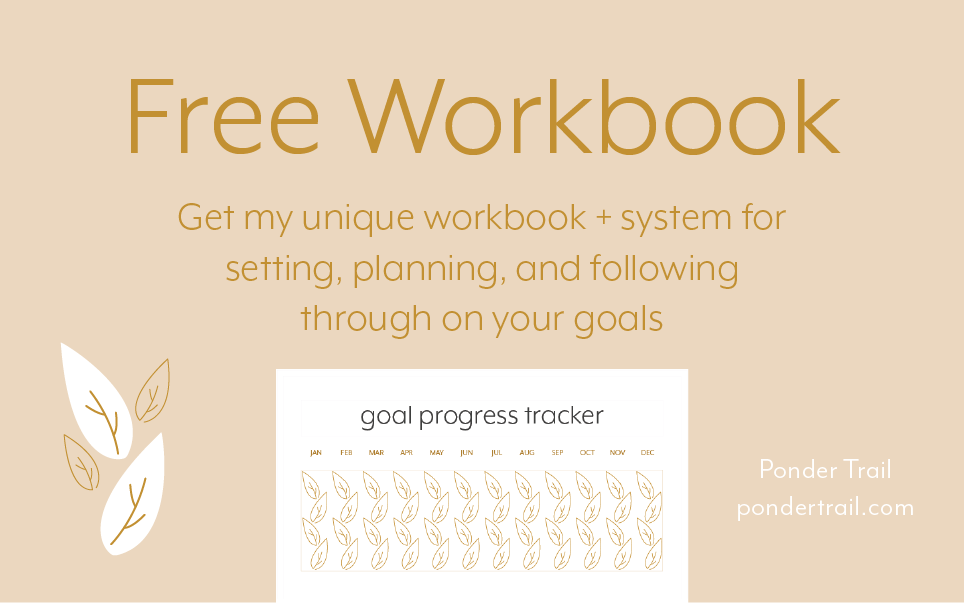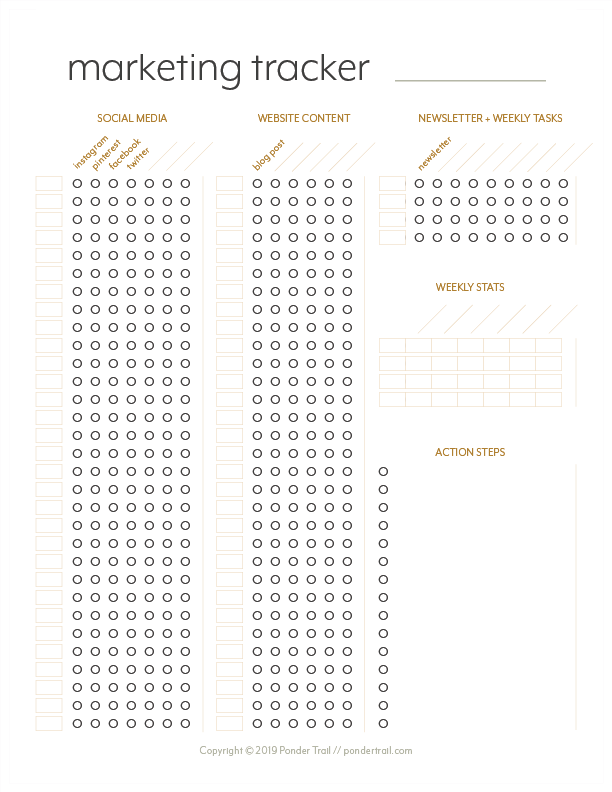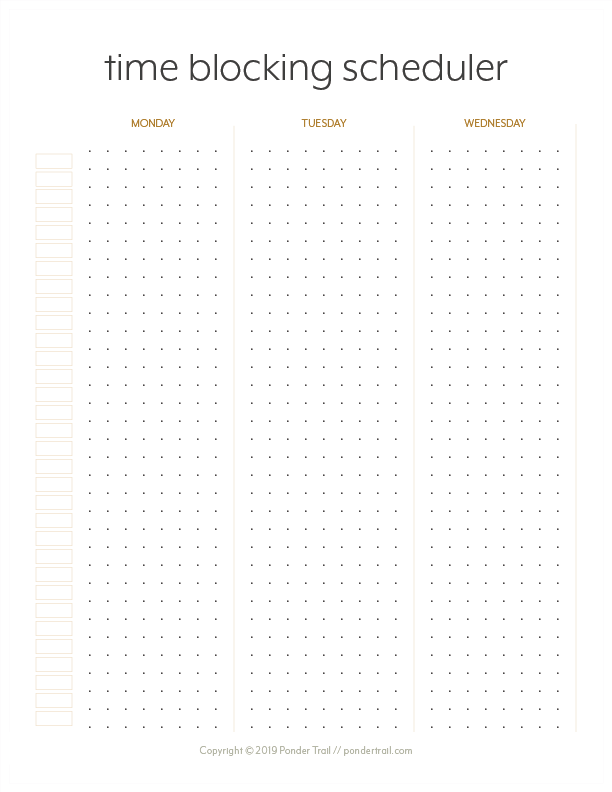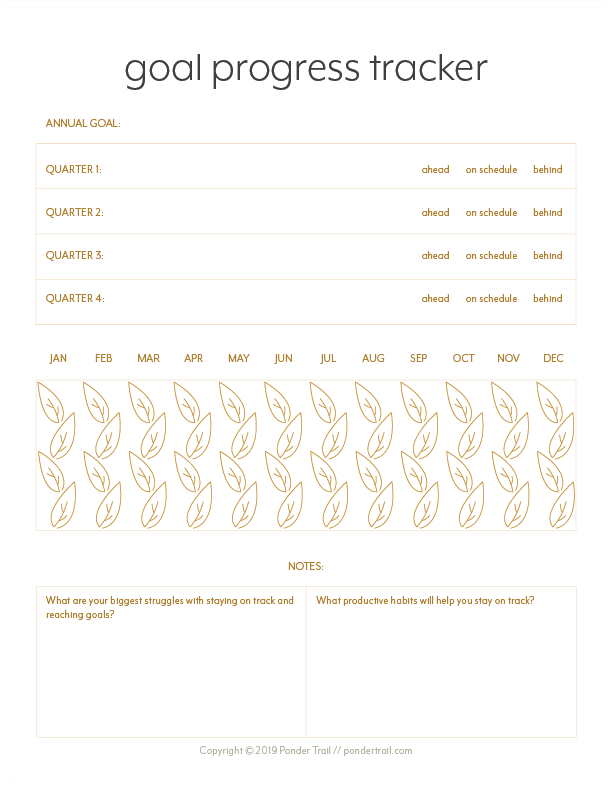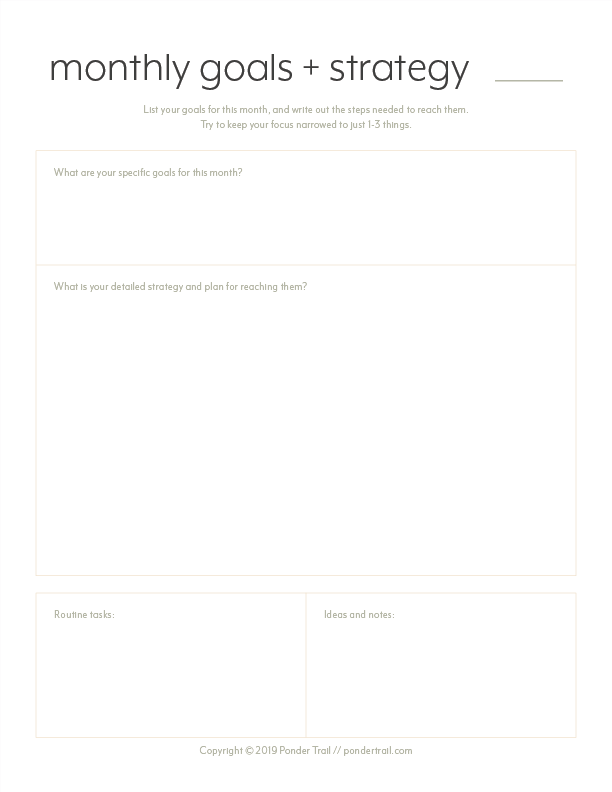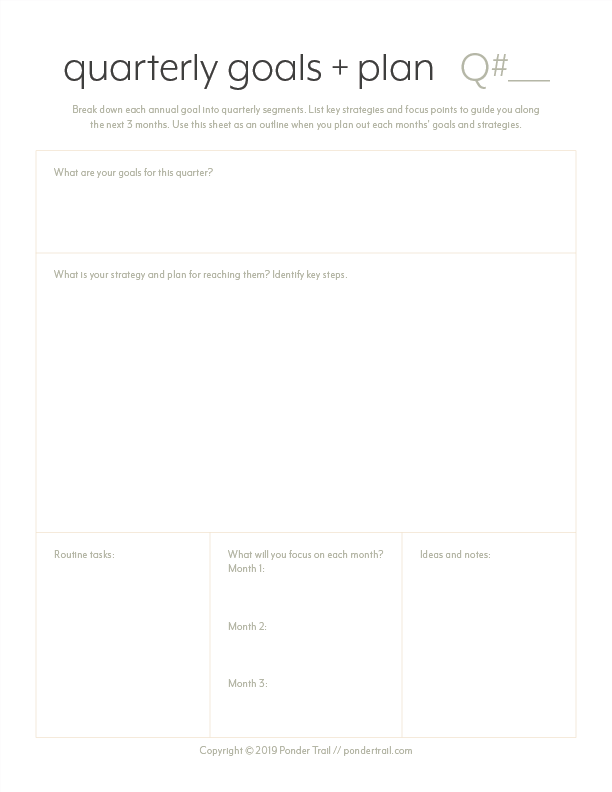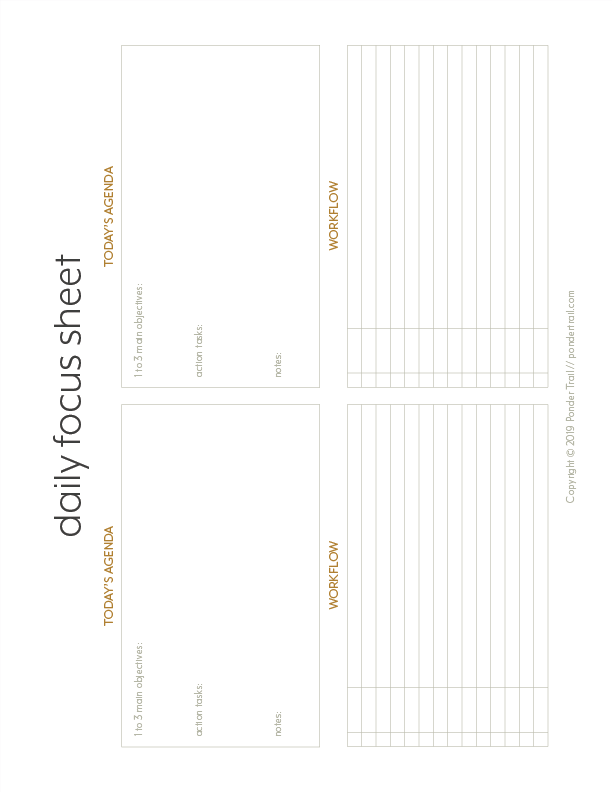How I Set, Plan, and Follow Through on My Goals
In my last Ponderstream Episode, I shared my step-by-step process for how I reach my goals. My process includes creating goals, breaking them down into daily actions, and monitoring your progress along the way.
Over the past year, I’ve focused on creating an effective and streamlined goal-planning system that saves time. Setting goals can be an easy place to get hung up on, so I wanted to outline a specific method that I could follow over and over again.
My goal was to be able to incorporate a step-by-step planning system into my routine to eliminate the pitfall of wondering where to start each day or what to work on next.
After over a year of experimenting and refining, I’ve ended up with a simple goal-planning process and created a workbook to go along with it. It’s made such a difference with reaching my goals, so I was excited to share it with you all last week in my livestream.
Essentially, my method for reaching goals is breaking them down all the way into simple to-do tasks that are assigned to each day. This creates a step-by-step plan for staying on track so you can monitor your progress and actually complete the tasks necessary to accomplish your goals.
There are 4 main sections: prepwork and laying the foundation, setting goals, planning them out, and following through. Join me as I walk you through the entire process in detail.
Missed joining this one live? Register for next week’s Ponderstream webinar here.
watch the Ponderstream episode:
blog post recap + show notes:
Prepwork + Laying the Foundation:
Lay the groundwork to help you create effective goals.
1 // Know your why for pursuing your business.
Before you dive into your goals, it’s important to lay the groundwork for why you want to have this business in the first place. Knowing your reasons for putting time and effort into your business endeavor is the first step to setting and reaching effective goals that benefit you in the long run.
List out your personal “why” behind having this particular business versus another business idea or versus pursuing a 9-5 job.
2 // Have specific ideas for your business’s direction and how it will be profitable.
The next step in laying a solid foundation for setting effective goals is to pinpoint a direction for your brand’s future and have an idea of the products or services you want to create.
When you establish a preliminary framework for your business offerings and know how your entrepreneurial venture will be profitable, it ensures you will set goals that grow your business and bring in an income. So write out how you plan to make money and list possible assets to create.
3 // Hone in on your niche and specialization.
Creating a niche and a specialization for your brand is a crucial step for setting goals that make your business successful. It takes away the distractions of the millions of possible ideas and leaves you with a clear path, which makes planning goals much more streamlined and effective.
Knowing the unique elements that set your business apart from all of the others in the sea gives you the ability to create goals that help those elements shine and become known.
Without a clearly defined niche and specialization, your business will likely lack luster and is much less likely to succeed. Plus, this is the most beneficial strategy for helping your business stand out in your industry and become a one-of-a-kind brand.
Setting Goals:
Establish goals for your business and list the necessary strategies and methods.
1 // Write out all of your dreams and goals // DREAM SHEET
First, list all of the things you want to do short-term and long-term in your business. Write down everything you can think of, and don’t hold back from including an overflow of ideas that clearly won’t fit into one year.
This step gets your creativity going and puts you in goal-planning mode. It also lets you clear your mind by getting all of your ideas out and in the open, which makes it easier to choose which goals you want to actively work towards next.
2 // Narrow down this year’s goals // ANNUAL GOALS SHEET
The next step is to narrow down what’s realistic and possible to achieve this year.
Since it’s tricky to figure out exactly what can fit into a year, I have a few methods to help you estimate accurately with this more difficult step.
To narrow down what’s possible and realistic . . .
01 | Establish your available hours
Figure out your routine and schedule and how much time you actually have available to dedicate to your business and goals each week.
Conduct a time audit of all your entire day for a full week to track your time and get an accurate idea of the hours you can spend working. List your activities and personal tasks each day, and write down the hours and minutes as you go.
02 | Determine how much time tasks really take // TIME BLOCKING SCHEDULER
To get an accurate idea of how long your business tasks take, first, draw boxes to create time slots that project when you’ll work on different tasks. Then, as you go throughout your day, track what actually happens and how much time you actually spend on tasks.
This helps you create a true-to-life work schedule and helps you see what will realistically fit into a day.
03 | Estimate strategies, methods, and steps needed to reach each goal
Identify and write out strategies and steps for each goal. Whether it’s marketing for a certain number of customers or clients, or producing a certain amount of inventory, list out ways you can make that goal happen and the methods you’ll need to follow.
Once you know what it will take to reach a goal, you can divvy out your available time and apply it to your different goals to get a good idea of what you can actually take on.
After you figure out which goals you can realistically work towards this year, readjust and rewrite your goals as necessary.
3 // Pinpoint S.M.A.R.T. goals and the strategies behind them // ANNUAL GOALS SHEET
Convert each of your goals into S.M.A.R.T. ones. This means Specific, Measurable, Attainable, Relevant, and Time-bound.
In other words, make every goal detailed and clearly defined, include numbers and quantities, ensure they are realistic, double-check that they relate to your business, and include a deadline.
This procedure turns them into actual goals instead of leaving them as loose ideas or dreams that err on the vague side. By defining each element in the S.M.A.R.T. system, your goals become much easier to plan out and track.
4 // Establish productive habits // ANNUAL GOALS SHEET
Good habits will help you save time and get things done, so brainstorm ways to improve your efficiency. The more effectively you work towards your goals, the more likely you are to achieve them.
Identify ways you might currently be wasting time, and figure out solutions. Then, incorporate those new productive practices into your routine.
Planning out Goals:
Break down goals, and create a plan of action with daily steps to execute.
Now it’s time to break down this year’s annual goals into quarterly, monthly, weekly, and daily segments. This takes away the daily need to figure out what to work on next, so you simply have to look at what’s on your list and execute it. Since it’s all broken down and planned out, it keeps you on track for reaching your goals as long as you complete your tasks each day.
1 // Create an overview for your entire year // ANNUAL PLAN + LAYOUT
List the goals, projectes, and all of the important things you’ll be working on during the year to get an overview. For each month, also include product launches, course dates, and when you have openings for your services. This will give you a picture of everything you plan to take on this year.
2 // Go into more detail at the start of each quarter // QUARTERLY GOALS + PLAN
Then, plan out your upcoming quarter in detail. List the specific goals you’ll be working on over the next three months, and brainstorm strategies that will help you reach your them. Identify key steps to break those strategies down. Include the routine tasks you will follow on a regular basis (like blogging and marketing), and choose a focus for each month in the current quarter.
3 // Get even more specific at the beginning of every month // MONTHLY GOALS + STRATEGY
On the monthly level, it’s time to get crystal clear on what you’ll be working on.
At the start of each month, get more specific with your goals. Try to focus on one overarching theme: marketing, blogging, or launching, for example.
Then, go into more detail with the strategies you will be implementing over the next thirty days. Map out the methods that need to be followed in order to reach your goals for the month. List out the recurring tasks you will be carrying out, too.
4 // Plan out your monthly tasks and events // PLANNER
Use this two-page layout to plan your month’s events and tasks in detail. This will give you a bird’s eye view of what you have going on over the next thirty days.
Include meetings, days you publish to the blog, when you send out your newsletter, and any projects you’ll be working on. Use the notes column to keep track of anything important.
5 // Come up with your monthly blog posts, and assign them to dates // EDITORIAL CALENDAR
Use this one-page calendar to fill out the content you will publish on your blog or podcast that month. Brainstorm blog topics and titles on a separate page or in the notes section at the bottom. Then, plug them into the calendar to map it out visually.
While a paper editorial calendar might seem more difficult to rearrange, this is often a benefit: writing your blog posts on paper means you’re more likely to stick to the order you lay out rather than moving it around if a certain post seems daunting.
6 // Each week, determine what you need to accomplish // WEEKLY MUST-DO LIST
A traditional to-do list often will overflow and spill over to the next month. So instead of continually transferring your tasks over to a future date—and thus, postponing your goals—utilize a Must-Do list.
Take your monthly goals, and write down the actions needed to make them possible. But don’t include any extra tasks on your list.
This method makes you much more careful about what you include on your list, which means you’ll be more intentional about putting time in the right places to get those things done.
7 // Every day, complete your assigned tasks // DAILY FOCUS SHEET
Once that’s in place, it gets easy because you don’t have to figure out what to do each day; simply complete the next day’s allotted work from your Must-Do list.
On your daily focus sheet, list your main objectives and action steps. Write down any important notes, too. Then, list out your day’s plan of attack and workflow.
Writing out your tasks gets them in the front of your mind so you’re more likely to stay focused and get things done.
Tip: Tracking your time each day helps you continually monitor and readjust how long tasks actually take you to complete.
For example, if you allot 3 hours to write a blog post, but you find that it keeps taking closer to 5 hours, you know to start blocking out 5 hours instead. Or you can implement more time-saving hacks and productivity tips to help you work more quickly.
Following Through:
Keep track of your progress to ensure you follow through on your goals.
Check off your daily and weekly marketing and content tasks // MARKETING TRACKER
Each day, check off the marketing to-do’s that you accomplish. This gives you a visual of how well you’re staying on top of your various daily and weekly tasks. It’s a great way to see if there are areas that aren’t getting done or that are getting overlooked.
Visualize how well you’re staying on track // GOAL PROGRESS TRACKER
The leaves represent weeks in the month. If you complete your tasks and are still on track for reaching your goal, fill in the leaf. If you don’t get everything done, leave it empty or half-filled depending on how much you checked off and how much you got behind. Leave them empty if there are weeks where you don’t get anything done.
As you go throughout the year, this creates a picture of how often you stay on track and how often you get behind and don’t get as much done.
This visual also helps you audit how much you get stuff done. For example, if you’re lagging behind, look at the leaf and its corresponding tasks on your planning pages. Maybe you were busy with other things, or maybe you were working really productively but still weren't able to reach them. This lets you see if you took on too many tasks that can’t actually fit into the allotted time. Then, you can adjust as needed.



